Engage NY Eureka Math 1st Grade Module 2 Mid Module Assessment Answer Key
Eureka Math Grade 1 Module 2 Mid Module Assessment Task Answer Key
Question 1.
Pedro has 8 pennies. Anita has 4 pennies. Olga has 2 pennies.
a. Whose pennies together make ten?
Answer:
8 + 2 = 10
Pedro and Olga pennies together make ten.
Explanation:
Pedro has eight pennies and Olga has two pennies. An addition sentence is a mathematical expression that shows two or more values added together and their sum. ADD eight pennies with two pennies then we got ten pennies. Pedro and Olga are having ten pennies together.
b. How many pennies do Pedro, Anita, and Olga have in all? Explain your thinking using a math drawing and a number sentence. Complete the statement.
Pedro, Anita, and Olga have ______ pennies in all.
Answer:
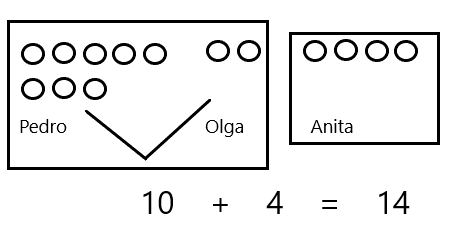
Pedro, Anita, and Olga have fourteen pennies in all
Explanation:
Pedro has eight pennies and Olga has two pennies and Anita has four pennies. Perform addition operation. An addition sentence is a mathematical expression that shows two or more values added together and their sum. ADD eight pennies with two pennies then we got ten pennies. Pedro and Olga are having ten pennies together. ADD Pedro and Olga pennies with Anita pennies. ADD ten pennies with four pennies then we got total number of pennies all together are fourteen.
Question 2.
Circle the pairs of numbers that make ten in each problem. Then, write the numbers that make the number sentences true. The first one is done for you.
a. 
- b.

Answer:
a.
b.
Explanation:
a. We have to Circle the pairs of numbers that make ten in each problem. - In the first number sentence we drawn a circle for nine and one which results ten. ADD ten with five then we got fifteen. Fifteen is the number that makes the number sentence true.
- In the second number sentence we drawn a circle for two and eight which results ten. ADD ten with six then we got sixteen. Sixteen is the number that makes the number sentence true.
- In the third number sentence we drawn a circle for three and seven which results ten. ADD ten with four then we got fourteen. Fourteen is the number that makes the number sentence true.
b. We have to Circle the pairs of numbers that make ten in each problem. - In the first number sentence we drawn a circle for eight and two which results ten. ADD ten with five then we got fifteen. Five is the number that makes the number sentence true.
- In the second number sentence we drawn a circle for nine and one which results ten. ADD ten with six then we got sixteen. six is the number that makes the number sentence true.
- In the third number sentence we drawn a circle for nine and one which results ten. ADD ten with seven then we got seventeen. seven is the number that makes the number sentence true.
Question 3.
Hakop has 6 pennies in a bowl. Nine pennies are in his drawer. How many pennies does Hakop have in all? Explain how you know with a labeled math drawing and number sentence. Complete the statement.
Hakop has _____ pennies in all.
Answer:
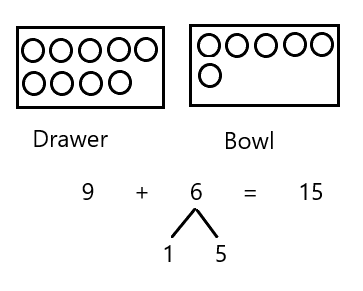
Hakop has 15 pennies in all.
Explanation:
In the above image we can observe Hakop has 6 pennies in a bowl. Nine pennies are in his drawer. In order to find the total number of pennies all together. We have to perform addition operation. ADD total number of pennies in a bowl with total number of pennies in a drawer. ADD nine with six then we got total number of pennies in all together are fifteen.
Question 4.
Write a number bond in each number sentence to show how to make ten.
a. 9 + 5 = 14
b. 8 + 5 = 13
c. 6 + 9 = 15
d. 17 = 8 + 9
Answer:
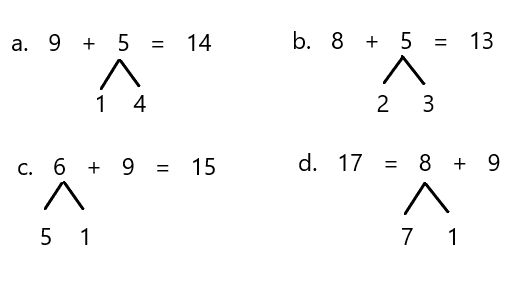
Explanation:
a. In the above image we can observe 9 + 5 = 14 number sentence . In that five is divided into two parts. One is four and another one is one. A number bond is a simple addition of two numbers that add up to give the sum. ADD one with nine then we got ten. By adding ten with four results fourteen.
b. In the above image we can observe 8 + 5 = 13 number sentence . In that five is divided into two parts. One is three and another one is two. A number bond is a simple addition of two numbers that add up to give the sum. ADD two with eight then we got ten. By adding ten with three results thirteen.
c. In the above image we can observe 6 + 9 = 15 number sentence . In that six is divided into two parts. One is five and another one is one. A number bond is a simple addition of two numbers that add up to give the sum. ADD one with nine then we got ten. By adding ten with five results fifteen.
d. In the above image we can observe17 = 8 + 9 number sentence . In that eight is divided into two parts. One is seven and another one is one. A number bond is a simple addition of two numbers that add up to give the sum. ADD one with nine then we got ten. By adding ten with seven results seventeen.
Question 5.
Eva has 6 marbles in her hand and 8 in her pocket.
a. Two students drew the pictures below to find out how many marbles Eva has. Label their drawings with P and H for Pocket and Hand. Write a number sentence to go with each drawing.

Answer:

Eva have 14 marbles.
Explanation:
In the above image we can observe Eva has 6 marbles in her hand and 8 in her pocket. Two students drew the picture to find out the total number of marbles. Two students labelled their drawing with P and H for Pocket and Hand. In the first image we can observe Eva have eight marbles in her pocket and six marbles in her hand. ADD eight marbles with six marbles then we got the total number marbles are fourteen. In the second image we can observe Eva have six marbles in her hand and eight marbles in her pocket. ADD six marbles with eight marbles then we got the total number marbles are fourteen.
b. True or false: You have to start with 6 marbles and then add the 8 marbles. (Circle one.) True False
Use pictures or words to explain how you know.
Answer:
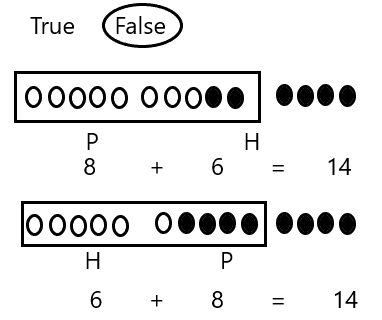
Explanation:
You can start with either as long as you add them all. So the answer is false.
c. Show two ways to find the number of Eva’s marbles that show how to make ten. Write a number sentence for each.
Answer:

Explanation:
In the above image we can observe two way to find out the marbles of Eva that makes ten. In first image we can observe total number of marbles in her hand and total number of marbles in her pocket. By adding ten marbles with four marbles results 14 marbles. In the second image we can observe total number of marbles in her pocket and total number of marbles in her hand. Six marbles are divided into two parts. In order to make ten, add eight with two. Adding ten marbles with four marbles results 14 marbles.
d. Jerry has 4 marbles in his pocket and 10 in his hand. Explain how it is that Jerry and Eva have the same number of marbles. Use words, math drawings, and numbers.
Answer:
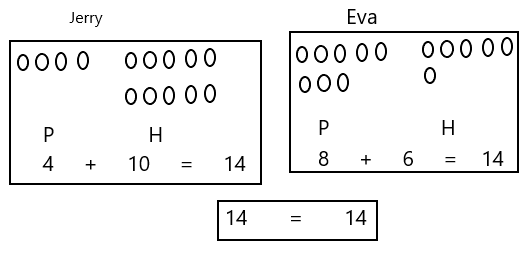
Explanation:
In the first image we can observe Jerry has 4 marbles in his pocket and 10 in his hand. In the second image we can observe Eva has 8 marbles in her pocket and 6 marbles in her hand. Jerry and Eva are having same number of marbles as shown in the above image.